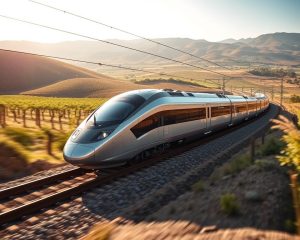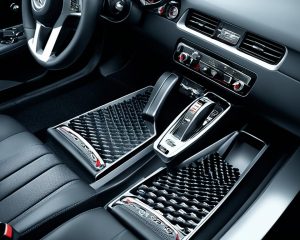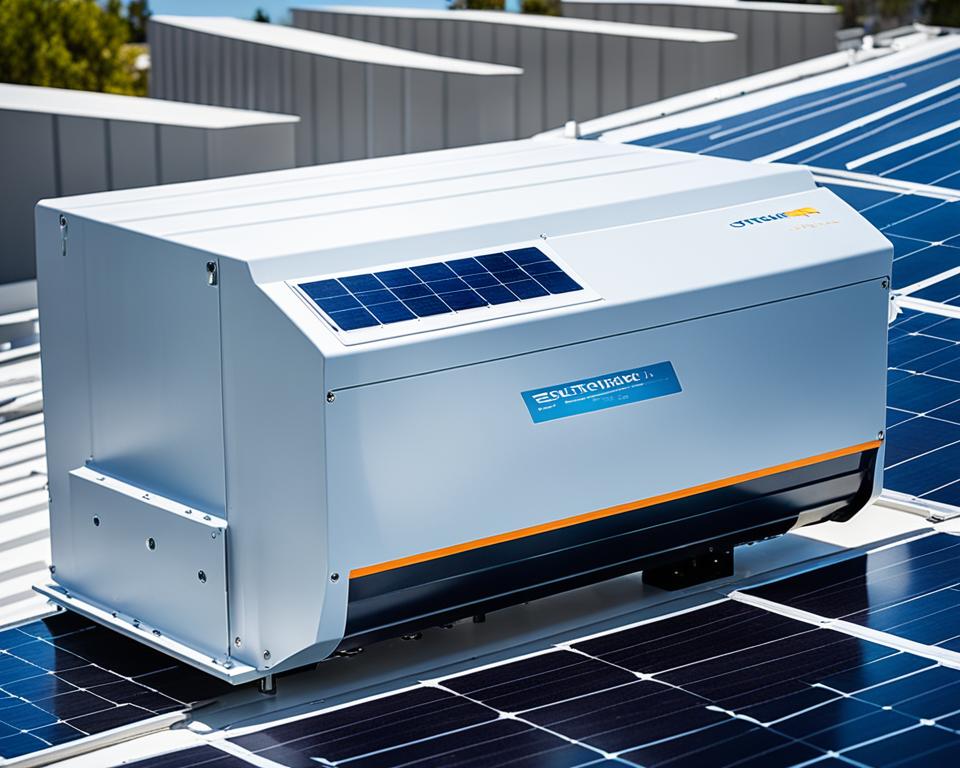
The solar inverter is key in making solar energy work well. It changes the direct current (DC) from solar panels into alternating current (AC). This AC is what homes, businesses, and the grid use.
Solar power inverters are vital for using solar energy in our daily lives. They help PV systems work better. This lets people and communities use the sun’s power more and help the planet.
Read interesting things at : web-quanto
Key Takeaways
- Solar inverters are the vital link between solar panels and the electrical grid or off-grid applications.
- They convert the direct current (DC) generated by solar panels into alternating current (AC) for use in homes, businesses, or the grid.
- Solar inverters optimize the performance and efficiency of photovoltaic (PV) systems, ensuring the seamless integration of solar energy.
- Advancements in solar inverter technology have contributed to the growth and accessibility of renewable energy solutions.
- Choosing the right solar inverter is crucial for maximizing the energy yield and overall performance of a PV system.
Introduction to Solar Inverters
Solar inverters are key in photovoltaic (PV) systems. They change the direct current (DC) from solar panels into alternating current (AC). This AC power can run homes, businesses, and even feed into the electrical grid. These devices are vital for using solar energy in our daily lives.
Importance of Solar Inverters in PV Systems
Solar inverters are vital for PV systems. They turn the DC electricity from solar panels into AC electricity. This AC power can power appliances, send energy to the grid, or store it in batteries for off-grid use. Without an inverter, solar panels’ energy would go to waste, making the system useless.
Types of Solar Inverters: A Brief Overview
The solar inverter market offers many options for different needs and uses. Here are some common types:
- Grid-tied inverters: These work with the utility grid, letting homeowners and businesses send extra solar power back to the grid.
- Off-grid inverters: Perfect for remote places, these inverters provide power to systems not connected to the grid.
- String inverters: Cost-effective, string inverters connect to many solar panels, turning DC power from the whole array.
- Central inverters: Used in big solar projects, central inverters manage power from many panels efficiently.
- Microinverters: These small inverters work with each solar panel, helping each one produce its best energy.
Knowing about these solar inverter types is key to designing a PV system that fits your energy needs and goals.
How Does a Solar Inverter Work?
Solar inverters are key in changing the direct current (DC) from solar panels into alternating current (AC) electricity. This AC electricity is what we use in our homes, businesses, and the electrical grid. Knowing how solar inverters work helps us understand how well a solar system performs.
A solar inverter changes the DC from solar panels into a stable AC. It does this with complex electronic parts and circuits. These parts work together to keep the voltage and frequency right.
- Solar panels make DC electricity, which goes into the solar inverter.
- The inverter uses transistors and capacitors to turn the DC into a high-frequency AC signal.
- This high-frequency AC is then cleaned up to become a pure sine wave. This is the type of AC we use in our homes and the grid.
- The inverter’s control systems make sure the AC voltage and frequency stay stable. This is important because the DC output from solar panels changes with the weather.
The solar inverter efficiency is key to a PV system’s performance. Efficient inverters turn more of the solar panel’s DC into usable AC power. This means more energy and less loss. New inverter technology is making solar energy systems better and cheaper.
| Inverter Type | Typical Efficiency Range |
|---|---|
| String Inverters | 95% – 98% |
| Central Inverters | 96% – 98.5% |
| Microinverters | 95% – 97.5% |
Understanding how solar inverters work and their efficiency helps people make better choices for their solar systems. This can make the system work better and save money.
“The solar inverter is the heart of a photovoltaic system, converting the raw DC power into usable AC electricity.”
The Role of Solar Inverters in Grid-Tied Systems
In the world of renewable energy, solar power systems need to connect with the electrical grid. Grid-tied inverters are key in this process. They link solar panels to the grid, making sure energy flows smoothly.
Grid-Tied Inverter Specifications
Grid-tied inverters have to meet certain standards for safe and reliable use. They keep the right voltage and frequency. They also have features like anti-islanding protection to keep workers safe during outages.
Benefits of Grid-Tied Solar Inverters
Grid-tied inverters bring big advantages to solar power systems:
- They let you sell extra solar power back to the grid, making money for you.
- They work well with the current electrical setup, avoiding the need for expensive off-grid systems.
- They make solar systems more efficient by stabilizing voltage and frequency.
- They help reduce our reliance on fossil fuels, moving us towards a greener future.
With grid-tied inverters, solar power systems can be part of the bigger energy picture. This helps make the power grid cleaner and more dependable.
“The integration of grid-tied inverters in solar power systems is a crucial step towards a sustainable energy future, enabling the efficient exchange of renewable energy and contributing to the wider grid network.”
Off-Grid Solar Inverters: Powering Remote Locations
In remote places, off-grid solar inverters are key for getting renewable energy. They turn the DC from solar panels into AC for devices and appliances. This is vital in areas without a power grid.
These off-grid inverter systems are great for remote homes and small businesses. They use the sun’s energy to provide power. This is a green and affordable way for people and communities to be energy independent.
Key Benefits of Off-Grid Solar Inverters
- Reliable, uninterrupted power supply in remote locations
- Reduced reliance on expensive and polluting fossil fuels
- Increased energy security and self-sufficiency
- Adaptability to various power needs and load requirements
- Compatibility with energy storage solutions like batteries
Off-grid off-grid inverter systems use batteries to store extra solar energy. This means there’s power even when it’s dark or the sun isn’t shining. Solar panels, inverters, and batteries work together for a strong off-grid power solution.
| Feature | Benefit |
|---|---|
| Reliable power supply | Ensures uninterrupted electricity for remote locations |
| Renewable energy source | Reduces reliance on fossil fuels and environmental impact |
| Energy storage compatibility | Provides power even during periods of low sunlight |
| Customizable power needs | Adapts to the specific requirements of the remote site |
More people want sustainable energy, so off-grid off-grid inverter systems are getting popular. They help power remote areas. This leads to energy independence and a cleaner future.
“Off-grid solar inverters are the unsung heroes of renewable energy, empowering remote communities and transforming lives beyond the reach of the traditional grid.”
String Inverters: A Cost-Effective Choice
In the solar power world, string inverters are a top pick for homes and small businesses. They change the direct current (DC) from solar panels into alternating current (AC). This AC is what homes and businesses use.
Advantages of String Inverters
String inverters have many benefits that make them popular. Let’s look at some key advantages:
- Simplicity and Ease of Installation – They’re easy to install, making them great for homeowners and small projects.
- Scalability – You can add or replace them as your solar needs grow, making it easy to increase your system’s size.
- Cost-Effectiveness – They’re cheaper than other inverters, which is good for those watching their budget.
- Reliability – Known for being durable, they provide steady power conversion for a long time.
These benefits, along with low maintenance, make string inverters a top choice for many solar users. As solar technology grows, string inverters stay a dependable and affordable way to power homes and businesses with green energy.
| Feature | Benefit |
|---|---|
| Simplicity and Ease of Installation | Streamlined setup process for homeowners and small businesses |
| Scalability | Ability to expand solar power capacity as needs grow |
| Cost-Effectiveness | Affordable option for budget-conscious solar energy users |
| Reliability | Durable and long-lasting power conversion for years of service |
“String inverters have become a go-to solution for homeowners and small businesses looking to harness the power of the sun in a cost-effective and reliable manner.”
Central Inverters: Ideal for Large-Scale Installations
Central central inverter are the top choice for big solar projects. They can handle a lot of power, making them perfect for big solar setups. This includes commercial, industrial, and utility-scale solar projects.
These inverters bring many benefits to large solar projects. They work well with big solar setups, turning a lot of energy into power. This means they can save money, especially for big solar systems.
Central central inverter are also very reliable and long-lasting. This is key for big solar projects. They can handle the tough demands of large solar setups, providing steady power for a long time.
| Feature | Benefit |
|---|---|
| High Power Input Capacity | Suitable for large-scale PV systems |
| Cost-Effectiveness | Economical option for large installations |
| Reliability and Durability | Consistent and long-lasting performance |
For big solar projects, central central inverter are a strong and efficient choice. They can manage a lot of power and are both affordable and reliable. This makes them great for big solar projects in business, industry, and utilities.
“Central inverters are the backbone of large-scale solar installations, delivering reliable and efficient power conversion for maximum energy yield.”
Microinverters: Maximizing Energy Yield
The solar industry is always changing, and one new tech is making waves: the microinverter. These are different from old-style string or central inverters. They work with each solar panel, making the system more efficient and boosting energy production.
How Microinverters Enhance System Efficiency
Microinverters change the DC power from each solar panel into AC power for the grid or batteries. This method beats traditional inverters in many ways:
- Independent panel optimization: Microinverters check and boost each solar panel’s performance. This means the whole system works better, even if some panels don’t do as well.
- Improved shading tolerance: Microinverters handle shading better. If one panel is shaded, it won’t slow down the whole system.
- Increased system flexibility: These systems are more flexible. Adding or changing parts is easier as energy needs change.
These benefits make microinverters a top choice for both homes and businesses. They help increase the energy a PV system can produce.
| Metric | String Inverter | Microinverter |
|---|---|---|
| Energy Yield | Lower | Higher |
| Shading Tolerance | Lower | Higher |
| Modularity | Lower | Higher |
This table shows how microinverters beat string inverters. They’re better at making energy, handling shade, and being flexible.
“Microinverters are changing solar tech. They let homeowners and businesses get the most energy from their PV systems, even in tough conditions.”
Selecting the Right Solar Inverter
Choosing the right solar inverter is key for any PV system. It changes the direct current (DC) from solar panels into alternating current (AC) for your home or the grid. With many options, it’s important to think about what your PV setup needs.
Factors to Consider When Choosing a Solar Inverter
Here are key things to consider when picking a solar inverter:
- System Size and Power Output: Figure out your solar panel array’s total wattage. Pick an inverter that matches this power rating. Make sure it can handle your PV system’s max power.
- Efficiency: Choose an inverter with high efficiency. This will help get the most energy and cut down on power loss.
- Compatibility: Make sure the inverter works with your solar panels, batteries (if you have them), and your electrical setup.
- Cost: Look at the upfront cost and any future maintenance or repair costs. This will help you find the best deal for your PV system.
- Warranty and Lifespan: Think about the warranty and how long the inverter is expected to last. This affects your PV system’s reliability and performance over time.
By considering these factors, you can pick the best solar inverter for your PV system. This ensures it works well and reliably.
“Selecting the right solar inverter is crucial for maximizing the performance and efficiency of your photovoltaic system.”
Solar Inverter Efficiency: A Crucial Factor
The solar inverter is key in PV systems, affecting efficiency and energy output. It’s vital for the system’s performance and cost-effectiveness. Solar inverter efficiency directly impacts how well a solar setup works and its cost savings.
Inverter efficiency is shown as a percentage, comparing output to input power. This is key to knowing how much solar energy is turned into usable electricity. It helps understand how much power from the PV panels is used or stored.
High-efficiency solar inverters boost energy yield and cut down on costs. They reduce power loss during conversion. This means more savings for homeowners and businesses on their solar investment.
Measuring Solar Inverter Efficiency
Efficiency is measured in several ways:
- European Efficiency: This rating shows how the inverter does in real-world situations. It’s a better way to see its usual efficiency.
- CEC Efficiency: The California Energy Commission rating looks at the inverter’s performance at different loads.
- Peak Efficiency: This is the inverter’s best efficiency, under lab conditions.
| Efficiency Metric | Description | Typical Range |
|---|---|---|
| European Efficiency | Shows how the inverter works in real life | 94% – 98% |
| CEC Efficiency | Looks at the inverter’s performance at different loads | 95% – 98% |
| Peak Efficiency | Shows the inverter’s top efficiency under certain conditions | 96% – 99% |
Knowing these efficiency metrics helps designers and homeowners pick the best solar inverter. This ensures the best energy production and savings.
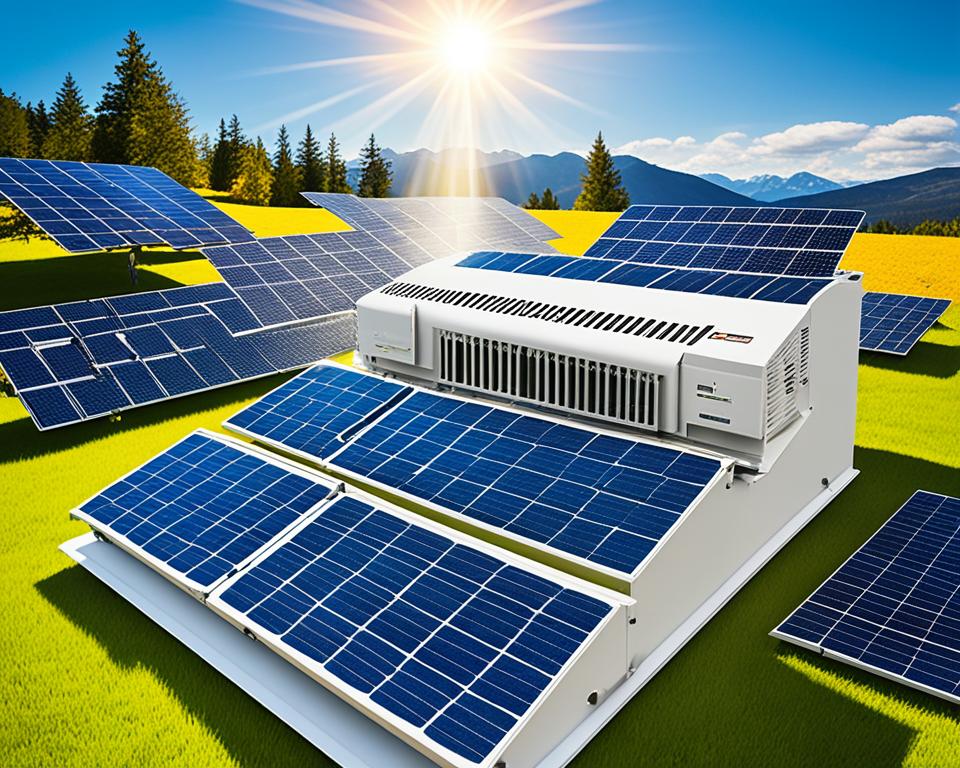
“Investing in a high-efficiency solar inverter is a smart choice for homeowners and businesses looking to maximize the return on their solar investment.”
The solar industry is growing, making inverter efficiency even more important. Focusing on this area lets solar system owners get the most from their setups. It helps make a greener energy future.
Monitoring and Maintaining Your Solar Inverter
Keeping an eye on and looking after your solar solar inverter is key for its long life and best performance. Regular care not only makes your inverter last longer but also boosts your solar energy system’s output.
Inverter Monitoring Systems
Today’s solar inverters have advanced monitoring systems. These systems give you real-time updates on your solar system’s performance. They track important things like energy made, voltage, and current. This lets you spot and fix problems fast.
Troubleshooting Common Issues
Regular checks can quickly spot and fix common solar inverter issues. These include overheating, communication problems, or output issues. Fixing these problems fast keeps your solar system running well.
Recommended Maintenance Practices
- Regularly clean the inverter and its area to keep it cool and well-ventilated.
- Look over electrical connections for corrosion or damage and fix them if needed.
- Update the inverter’s firmware to get the latest software, which might fix bugs and improve performance.
- Have a yearly check by a pro to catch any issues or wear early.
| Maintenance Task | Frequency |
|---|---|
| Cleaning the inverter | Every 6 months |
| Checking electrical connections | Every 6 months |
| Firmware updates | As available |
| Professional inspection | Annually |
With a good monitoring and maintenance plan, you can make sure your solar inverter works well for a long time. This makes the most of your investment in renewable energy.
“Regular maintenance is the key to unlocking the full potential of your solar PV system.”
Renewable Energy Inverters: Paving the Way to a Sustainable Future
The world is turning to renewable energy sources more and more. Renewable energy inverters are key to this shift. They connect renewable energy systems to the electrical grid, making it easier to use clean power.
Renewable energy inverters change the DC power from solar panels and wind turbines into AC power for the grid. These devices boost energy efficiency and help keep the grid stable and reliable.
Modern renewable energy inverters make renewable energy systems better and more reliable. They adjust the electricity flow to keep the power steady, even when the weather changes or energy demand shifts.
“Renewable energy inverters are the unsung heroes of the clean energy revolution, transforming the way we power our world and paving the way to a more sustainable future.”
Thanks to new renewable energy inverter technology, energy conversion is more efficient. This means less energy loss and more power from renewable sources. It makes renewable energy cheaper and easier to use for homes and businesses.
The importance of renewable energy inverters will keep growing as we move towards a sustainable energy future. These technologies improve renewable energy systems and help create a cleaner, more resilient energy world for everyone.
Photovoltaic Inverter Innovations
The world of photovoltaic inverters is always changing. This is because we’re always looking for better efficiency, reliability, and functionality. As solar energy grows, researchers and engineers are making new technologies. These new technologies are changing how we use and manage solar power.
Emerging Technologies in Solar Inverter Design
Wide-bandgap semiconductors are a big deal in photovoltaic inverters now. Materials like silicon carbide (SiC) and gallium nitride (GaN) have better electrical properties. This lets inverters work at higher voltages, frequencies, and temperatures. This means we can make inverters that are smaller, more efficient, and cheaper.
Advanced control algorithms and machine learning are also big news. These tools help photovoltaic inverters work better, adapt to changes, and predict problems. This is key for getting the most energy from solar PV systems.
Wireless communication and smart grid integration are becoming more common in photovoltaic inverters. Inverters with wireless tech can connect easily to monitoring systems and energy platforms. This lets us do remote checks, analyze data in real-time, and work better with the electricity grid. It’s helping us move towards smarter, more efficient energy use.
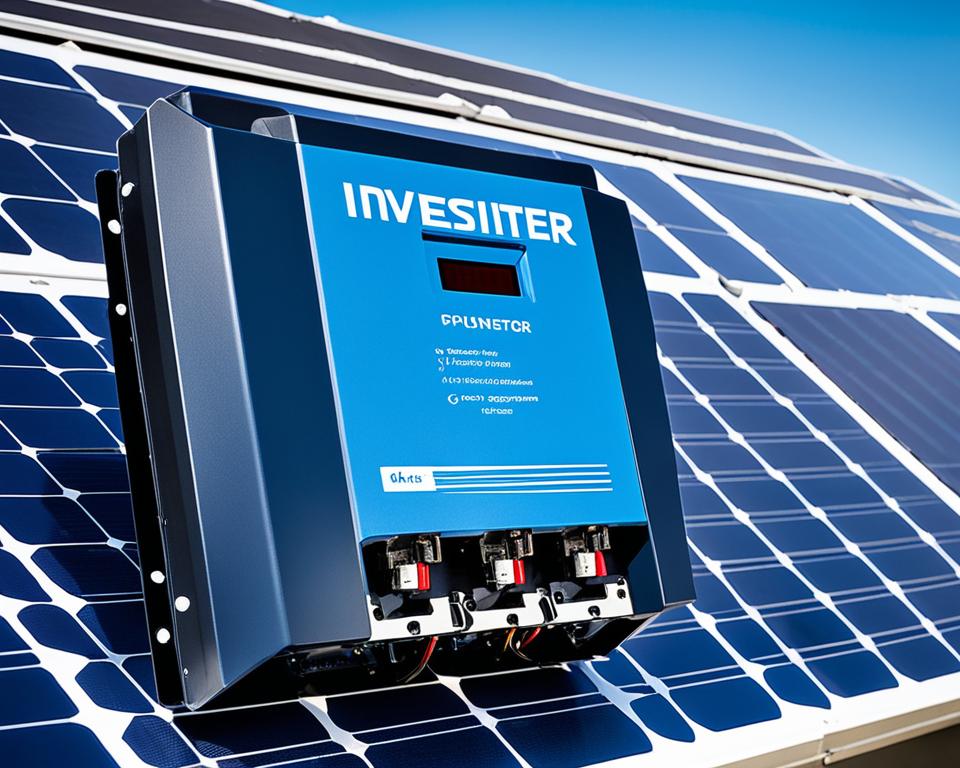
Modular and scalable inverter designs are changing how we set up solar PV systems. These designs offer more flexibility, make maintenance easier, and let us customize the inverter for each installation. This means lower costs and better system performance.
As we keep moving forward, the improvements in photovoltaic inverter design will be key. They will help solar energy become more popular and push us towards a sustainable future.
The Solar Inverter: A Vital Component in PV Systems
The solar inverter is key to making PV systems work well. It changes the direct current (DC) from solar panels into alternating current (AC). This AC can be used in the electrical grid or for off-grid setups.
Solar inverters have different types, each with its own benefits. There are string inverters, central inverters, and microinverters. Each type meets the needs of PV systems, whether they connect to the grid or not. Choosing the right solar power inverter affects a solar energy system’s performance, efficiency, and cost.
The solar inverter is essential for PV systems. It helps bring renewable energy into our daily lives. As we move towards a sustainable energy future, the solar inverter’s role will grow. It makes sure solar power is fully used and reliable.
